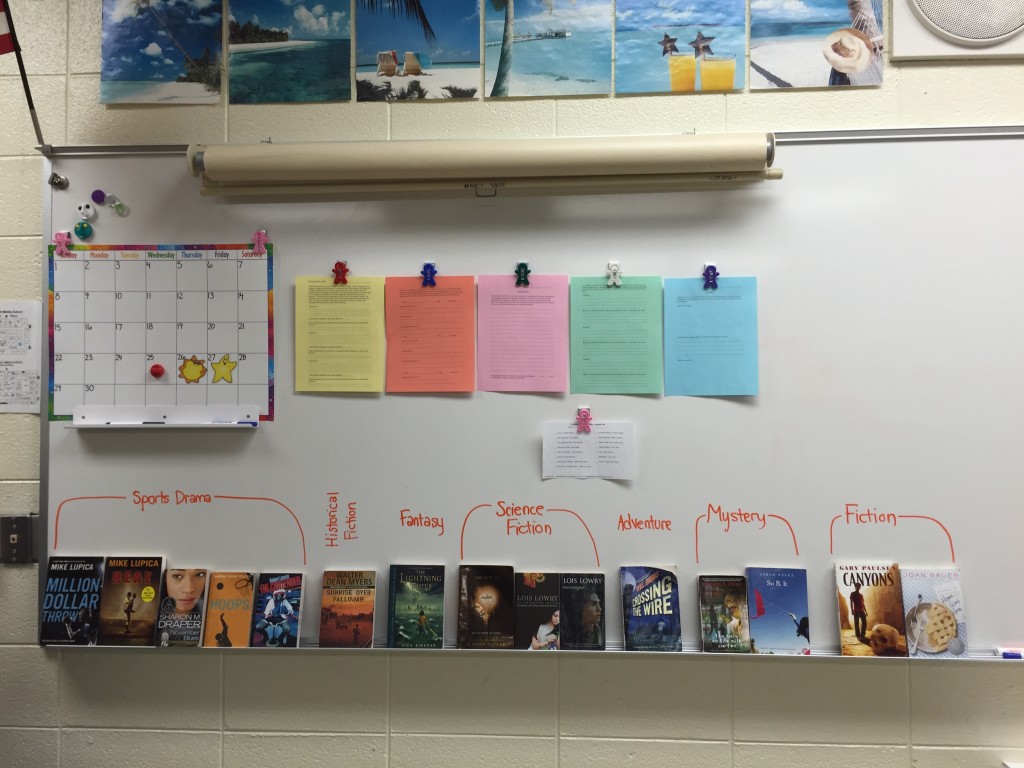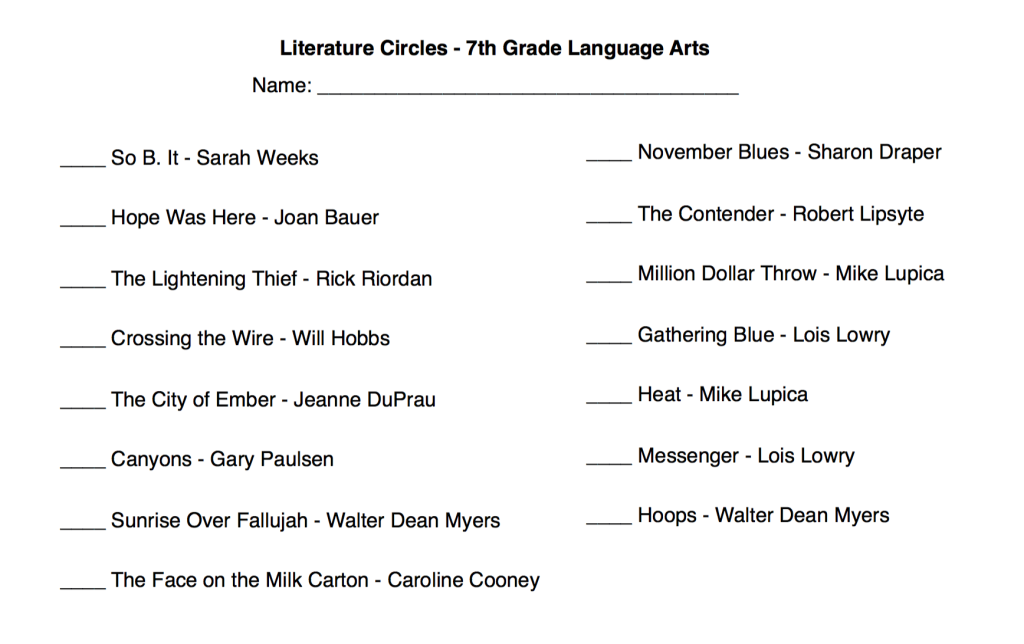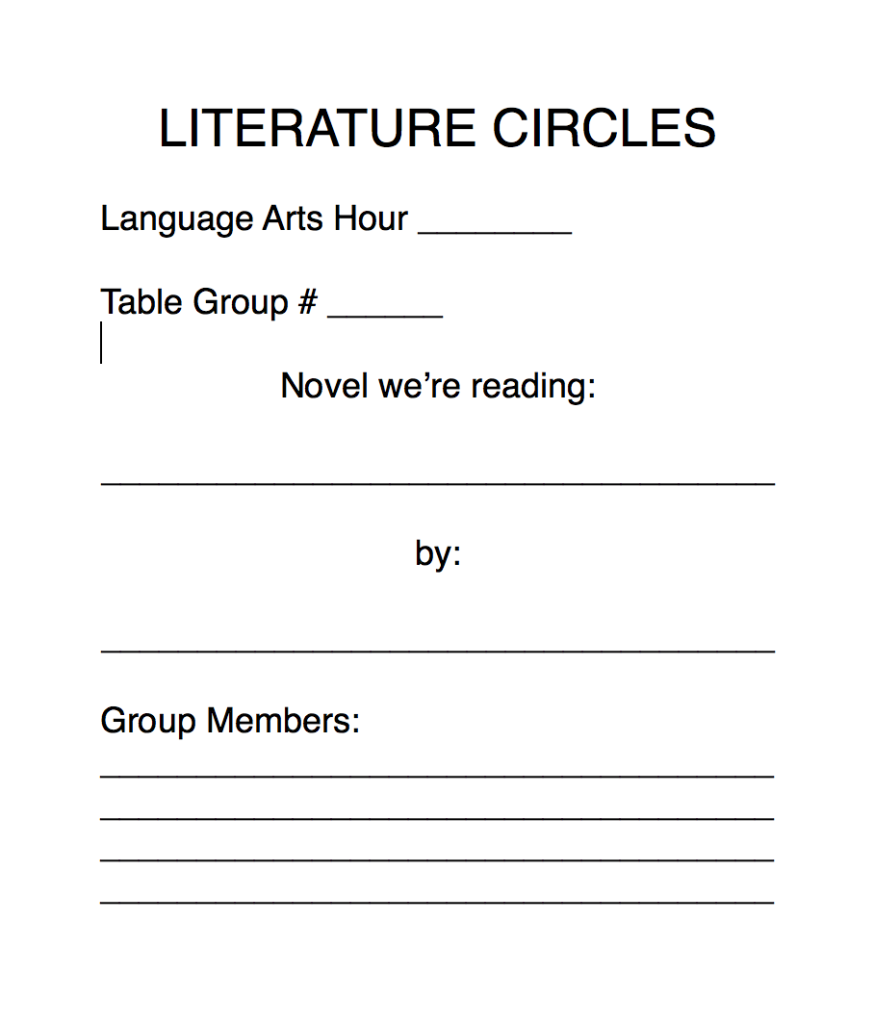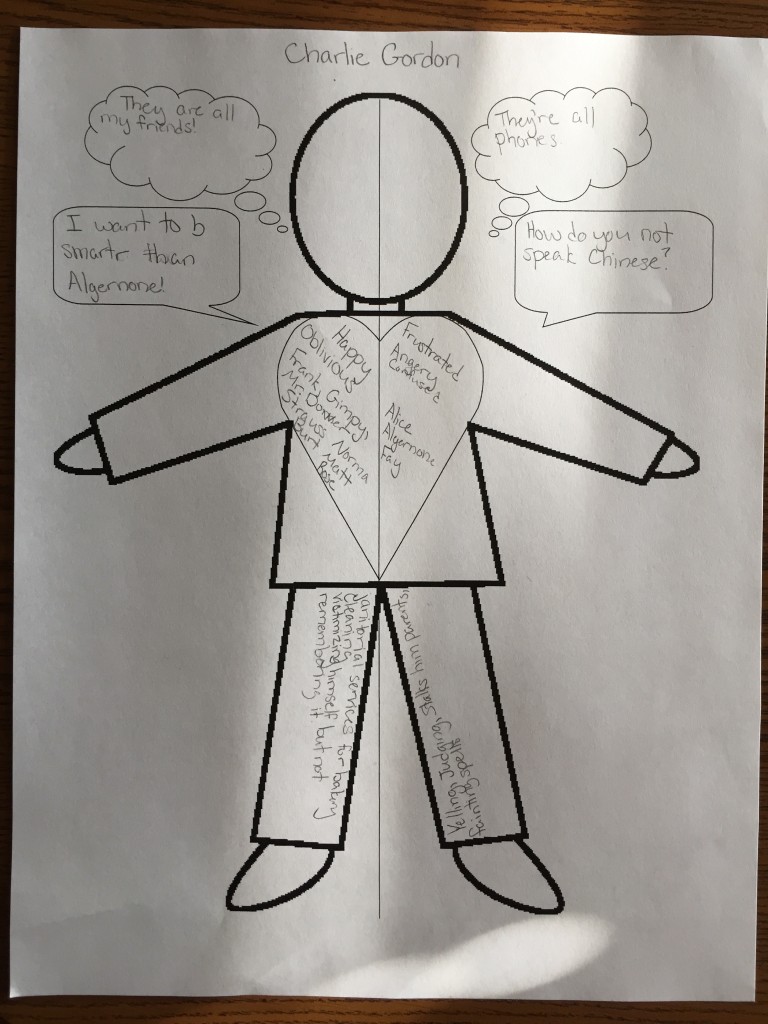Dec
2015
Literature Circles
This is my first year teaching 7th grade, and my first time teaching Literature Circles. A Literature Circle is when a small group of students read a shared book and discuss it as they go, as opposed to the entire class reading the same book in a novel unit. I thought I would share how it went, what we did, and what I would do differently next time. It’s a great experience for students, and definitely the perfect learning activity for cultivating a love of reading.
It was a lot of work to set up the Literature Circles, but once we got them started, it was a breeze. I began by going through my cupboards and pulling out books that I had multiple copies of (at least 4 per class, and I teach 4 classes).
I organized the books on my front board by genre, since that is usually the first thing I like to know about a book. I also looked up the Lexile levels for each of the books, noting for myself which novels were significantly above or significantly below grade level. Next, I printed and copied half sheets of paper for each student as shown below:
On our Literature Circle kick-off day, I began by simply reading the titles of the books in order. Then I stopped talking. Yes, this is hard for teachers, but you gotta do it – just stop talking! Resist the urge to say everything you know about a book and divulge why you love it. It’s so much more fun to put them into the driver’s seat and let them explore the books that interest them. Otherwise they’d be sitting there listening to you blather on and on about a book they have zero interest in, just dying for you to get to the one they want to hear about. That really takes the fun out of it.
I distributed the half sheets and explained that by the end of the hour, every student needs to rank his/her top 4 book choices. Next, I let them explore the books that interested them. I handed out copies of the books and encouraged students to read the backs and the first couple of pages to make sure the book would be a ‘right fit’ for them. I also pointed out which books were high or low Lexile levels, since that can be an important factor in selecting a novel. I know the students were looking at the number of pages, too, and that’s important as well. Why pick a really long book when you know you will struggle to finish it? I told my students that it’s important to have reasonable expectations and chose a book that you will both enjoy and be successful at.
I gave students all hour to explore the novels and make their choices. At this point, I bet you’re nervous that students began scheming and selecting books that their friends wanted to read. I am happy to report that the scheming was at a minimum. I made sure to emphasize that I can’t guarantee that every student will get his/her top pick, and that it is so very important to pick a book you will be successful with for the next month.
After school comes the hard work. You have to lay out all of the half sheets and organize the students into groups. I aimed for groups of 3 – 5. I would say that about 1/3 of the students got their top pics, but every student got a book in his/her top 4. I also made some mindful decisions to separate particular personalities, a concern that all teachers bear in mind when making groups.
On Day 2, I announced the Literature Circle groups. We rearranged the room so groups could sit together, and every group had to fill out a cover sheet for their group folder as shown above. The folders were kept in the room at all times (especially important for absences!). Then, I distributed the novels and explained the procedure for the next month.
Every 3 school days, we would have a Literature Circle Meeting. In total, there would be 5 Meetings. Therefore, the groups must divide their book into fifths and determine how much they would need to read to be prepared for each of the 5 meetings. Also, everyone will perform a different role at each of the Meetings. The roles include:
- Discussion Leader (write 3 – 5 discussion questions)
- Word Smith (choose 3 – 5 interesting, key, important vocabulary words)
- Journaler (illustrate and explain 3 key scenes)
- Summarizer
- Line Lighter (choose 1 – 2 key passages and explain their significance)
Over the course of 5 meetings, everyone must perform each of the 5 roles once. Before we even began reading, I had each group make a plan for how many chapters/pages they needed to read for each meeting, and who would perform which roles at each meeting. Even if a student is absent, he/she is still responsible for their reading and role – which they know well in advance.
With all that hard work and planning out of the way, it was time to simply let the students read! They were responsible to themselves and each other for being prepared and staying on top of their obligations. Since they chose their own books, I believe they were much more interested and invested in this learning unit. Students wanted to read, and they were excited to talk about their books. I made a point of saying that I believe Literature Circles remind us why people love to read; they love to have someone with whom to share ideas and excitement about their reading.
Literature Circle Meetings
Every 3 school days (time for students to read), we held a Literature Circle Meeting. For the first one, I gave the students a challenge, because students love challenges! I put 8 minutes on my timer and explained that I wanted the groups to talk about their books and ONLY their books for the full 8 minutes, non-stop. I asked them if that sounded like a lot, too little, or just the right amount of time. They agreed it was a wimpy challenge, no problem! Next, we discussed how they would fill up the 8 minutes. I explained how each group member should explain his/her role and share the worksheet they completed. Then, group members should give him/her feedback on their roles. Sounds easy enough, right? Almost every group sped through and finished in less than 5 minutes. Not so wimpy of a challenge!
I had prepared for this outcome, however. While students were discussing, I went around the room (checking for work completion) and placed a laminated discussion card or two at each table group. I purchased the discussion cards from Rachel Lynette here. They are a fantastic resource! Thanks to these cards, we kept the conversation going a bit longer.
After our first meeting, I also took the opportunity to have a mini lesson on what makes a good discussion question. I had prepared a few questions ahead of time that typified clarifying and discussion questions, and we discussed the differences between the two. After Meeting #1, students felt confident that they would exceed expectations for Meeting #2.
Extension Activities
In addition to each of the 5 Literature Circle Meetings, I also planned 5 extension activities for each of the meetings:
- Before / After graphic: Meeting #1: As a class, we discussed how main characters are always dynamic, meaning they change in some important ways throughout the course of a novel. I used this graphic from Creatively Composing to help students work through how a main character in their novel changed. At our first Meeting, I only had them fill out the left side of the body, indicating a typical thing their character would think, say, feel, or do. We finished the graphic later, at Meeting #4.
- Symbolic Item: By Meeting #2, students had a pretty good grasp of what kind of person their main character is. I had them select a symbolic item (one that could fit in a paper bag) to represent their character’s personality. The hitch? It could NOT be an item from the book – they had to think outside of the box. We got some pretty creative, abstract, and interesting ideas for this one!
- Book Trailer: At Meeting #3, I had students look up a book trailer for their novel on Youtube. I had them watch and critique it to the class, sharing what they liked, what they thought the author got right, and what they would have changed about the trailer if they had made it.
- Before/After graphic: At Meeting #4, I had students complete the right side of their Before/After graphic, indicating how their character has changed. Then, we shared as a class. Students noted a theme – most of the characters changed in their feelings or thoughts, not always their speech or actions.
- Rebrand Your Book: At Meeting #5, the end of the novel, I told students that they were being ‘hired’ by a publishing company to rebrand their book to increase sales. They needed to give it a new title and cover art. They presented to the class and defended their choices.
In addition to the 5 Meetings and these 5 Extension activities, we also had Library Tuesday and Informational Text Wednesday, just to add variety to our weeks.
Reflection
What would I do differently next year?
- Change up the novel selection – As it turns out, I would probably remove Sunrise Over Fallujah for 7th graders. I’d also like to add more fantasy and historical fiction options.
- Less Busy Work – Reading is supposed to be fun. The group roles / worksheets? Not fun. I know I need a way to keep tabs on students and make sure they are keeping up with their reading, but maybe I could streamline this a little bit (or a lot). I don’t want to ruin the experience with banal, meaningless work.
- Modeling – I’d like to do a performance Literature Circle for students, maybe a couple of teachers modeling the do’s and don’ts of how to run a Meeting?
- Seating Charts – I have assigned seating in my room, and I normally change up the seats every 2 weeks. I do this to help students learn to interact with each other and to discover new ideas. For this month, I grouped students by their novels, and they sat together the entire time. I wish I hadn’t done this. I wish that the only times that students sat with their Literature Circle groups were for actual meetings. This way, they could be learning about other books throughout the month, and they could save their thoughts about their own books just for the Meetings.
- Book Pitch – At the end of the month, I’d like students to try to pitch their book to other students in the class. Who better to get you excited to read a new book than a fellow student?
What did I get just right?
- Timing – I’m glad I gave them as much time as I did to read in class (3 class days between meetings). I know this is a bit pessimistic to say, but I worry that without giving them in-class time, many books would not get read.
- Informational Text – I’m very glad we continued to spend one day a week working on informational text. No one likes to do the same thing all day every day for a month straight! We also got to keep up on our other reading skills.
- Discussion Time Challenge – At each meeting, I gave them a time challenge, and I increased my expectations by one minute each time. The first meeting was 8 minutes, and the last was 12. I put a timer on the board so students could monitor themselves. I think this was an important, appropriate challenge for middle schoolers to monitor each other and stay on task for an extended period of time.
So there you have it – my first attempt at Lit Circles. I’d love your feedback! Please comment below on what you’ve done in the past, or any other suggestions you might have for making Lit Circles a success!
![]()




Theresa
December 30, 2015 at 10:09 pm (10 years ago)Sounds awesome! Did you have issues with any students NOT being prepared or being absent repeatedly on meeting days?
kdembro
December 31, 2015 at 8:40 am (10 years ago)You know, I did have a few students who were not prepared (hadn’t finished their group role sheets) for the meetings, BUT I can say that everyone did their reading. That is why I am glad I provided in class time to read. Those students were still able to participate in the discussion and extension activities. This is also what makes me rethink the purpose of those worksheets anyway. Maybe they aren’t necessary!
stacy baldwin
July 28, 2016 at 7:42 pm (9 years ago)This is exactly the way I did my Lit circles! I loved it, the students loved and so did their parents. I did incorporate journal entries using higher level DOK questions as well and discussion boards.